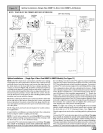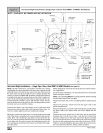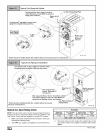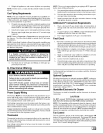
2. Checkholesizesbymakingsureitissmallerthan the cou-
plings or elbows that will be installed on the outside. The
couplings or elbows MUST prevent the pipe from being
pushed back through the wall.
3. Extend vent pipe and combustion air pipe through the wall
3/4" to 1" and seal area between pipe and wall.
4. Install the couplings, nipple and termination elbows as
shown and maintain spacing between vent and combus-
tion air piping as indicated in Figure 19 and Figure 20.
A metal shield is recommended 18" x 18" min. or 18" rain. diame-
ter around the vent termination at the exterior wall to protect the
house exterior materials from flue product or condensation (freez-
ing) damage.
UsingExterior Risers
1. Install elbows and pipe to form riser as shown in Figure 20.
2. Secure vent pipe to wall with galvanized strap or other rust
resistant material to restrain pipe from moving.
3. Insulate pipe with Armaflex or equivalent moisture resis-
tant closed cell foam insulation or Fiberglass insulation if
boxed in and sealed against moisture.
ii Sidewall Termination with Exterior
Fi_2_ : Risers to Get Above Snow Level or
Grade Level
8"_ _ / 18 Mmtmumfor coldchmates
MIN. J / _-_ (substainedbelow0° F)
20' _'_
: =
%. / 8NOW LEVEL _=Sq30-04F
Vertical Termination
1. Figure 21 shows the proper installation and clearances for
vertical vent termination. The vertical roof termination
should be sealed with a plumbing roof boot or equivalent
flashing. The inlet of the intake pipe and end of the exhaust
vent must be terminated no less than 12" above the roof or
snow accumulation level, and 12" away from a vertical wall
or other protrusion.
2. If the vent system is installed in an existing chimney make
sure clearances shown in Figure 21 are maintained. Hori-
zontal section before the termination elbow can be ex-
tended on the inlet air to provide necessary clearance.
Rooftop Termination
A = 12" Above roofor snow accumulationlevel
B= 8" Min.,20' Maximum,except in areaswith extreme coldtemperatures
(sustainedbelow0°% the18" Min.
Vent Termination Shielding
Under certain wind conditions some building materials may be af-
fected by flue products expelled in close proximity to unprotected
surfaces. Sealing or shielding of the exposed surfaces with a cor-
rosion resistant material (such as aluminum sheeting) may be re-
quired to prevent staining or deterioration. The protective material
should be attached and sealed (if necessary) to the building be-
fore attaching the vent terminal.
Multi Vent Termination Clearances
When two (2) or more furnaces are vented near each other, each
furnace must be individually vented.
Two (2) vent terminations may be installed as shown in
Figure 22, Figure 23, Figure 24, Figure 25, Figure 26 and
Figure 27, but the next vent termination must be at least 36" away
from first 2 terminations. It is important that vent terminations be
made as shown to avoid recirculation of flue gases.
Concentric Vent and Combustion-
Air Roof Termination
12"Min. Gradeorl
Snow Level
Combustion
Air
Dimension "A" is touching or 2" maximum separation.
[_ 44001 111400


















